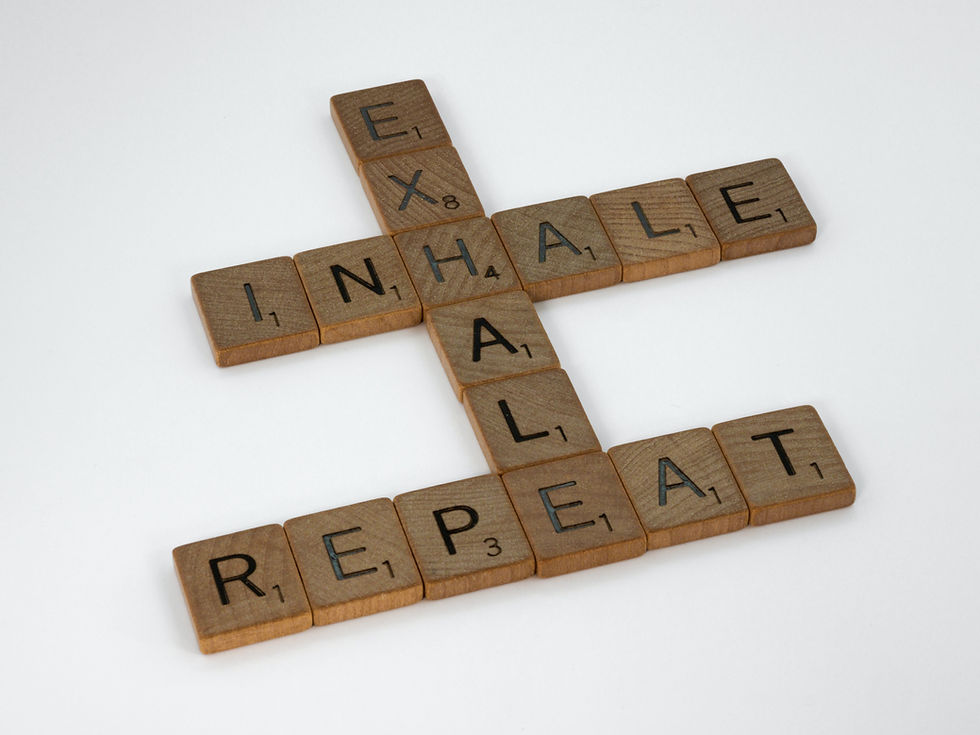Breathing Exercises for Stress Management
- Vanessa Barajas, MPH
- May 11, 2022
- 3 min read
Written by Vanessa Barajas, Program Coordinator at Work2Live
Paying attention to how we breathe is something that is easy to overlook, considering it’s completely automatic. However, our breath is a powerful thing! Becoming aware of it and incorporating breathing exercises into our daily routine has many benefits, including managing stress, increasing focus, and enhancing performance. Deep breathing is a good way to relax from a busy day too.
When you breathe in deeply, blood cells receive more oxygen and release more carbon dioxide. Carbon dioxide is a waste product that's carried back through your body and exhaled. Most adults breathe from the chest, which is known as shallow breathing. Shallow breathing can upset the oxygen and carbon dioxide exchange and contribute to anxiety, panic attacks, fatigue, and other physical and emotional disturbances. Let’s take a look at the various breathing exercises you can try today.

If at any point you feel discomfort (lightheaded, dizzy, shortness of breath, etc.) during any of the breathing exercises, please stop doing the exercise immediately. Talk with your doctor before starting the exercises if you have a medical condition such as asthma, COPD, or any other lung or heart concern.
4-7-8 Breathing
This exercise acts as a natural tranquilizer for the nervous system. At first, it's best to perform the exercise seated with your back straight. Once you become more familiar with this breathing exercise, however, you can perform it while lying in bed.
Place and keep the tip of your tongue against the ridge of tissue behind your upper front teeth for the duration of the exercise.
Completely exhale through your mouth, with pursed lips (like you’re blowing out a candle).
Close your mouth and inhale quietly through your nose to a mental count of four.
Hold your breath for a count of seven.
Exhale completely through your mouth, with pursed lips to a count of eight.
Pursed-Lip Breathing
Pursed-lip breathing is a simple breathing technique that will help make deep breaths slower and more intentional.
Sit in a comfortable position with your neck and shoulders relaxed.
Inhale slowly through your nose for two seconds.
Exhale through pursed lips for four seconds
Keep your breath slow and steady while breathing out. The key is to make the breath out approximately twice as long as the breath in.
Box Breathing
This is a simple but powerful relaxation technique that can help return your breathing pattern to a relaxed rhythm.
Inhale to a count of four.
Hold your breath for 4 seconds.
Exhale to a count of four.
Repeat these steps as many times as you’d like.
Abdominal Breathing
This technique can help create a feeling of calm composure, renewed energy, and focus.
While sitting, with one hand on the chest and the other on the belly, take a deep breath in through the nose, ensuring the diaphragm (not the chest) inflates with enough air to create a stretch in the lungs.
Exhale slowly through pursed lips. Start with repeating this 3 times. You can work up to 6-10 deep, slow breaths per minute for 2-3 minutes.
Alternate Nostril Breathing
This involves blocking off one nostril at a time as you breathe through the other, alternating between nostrils in a regular pattern.
Sit comfortably in a chair with feet flat on the floor (or cross-legged if you’re comfortable with doing so) and place your left hand facing up on your left leg.
Begin with exhaling through both nostrils.
Using your right hand, close the right nostril with the thumb. Then inhale slowly through the left nostril.
After completely inhaling, close the left nostril with your index or ring finger and then open the right nostril and exhale through it.
Inhale through your right nostril.
Close off your right nostril with your thumb.
Open and exhale through your left nostril.
Inhale through your left nostril.
You can do 3 rounds of this breathing pattern until you work up to 10 rounds. Remember if you begin to feel lightheaded, stop this exercise and return to your regular breathing.
The power of the breath cannot be overstated. It has the ability to help us heal mentally, physically, and emotionally and can improve many aspects of life if we take the time to pay attention to it.










Comments